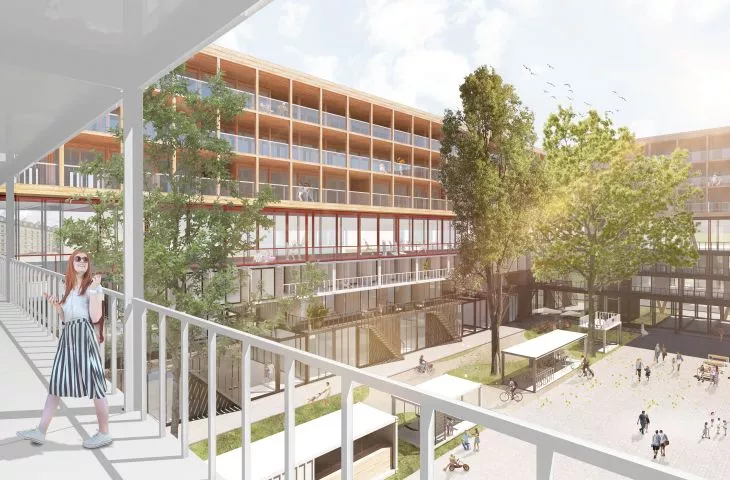Justyna Dmytryk and Maja Klawitter, students of the Faculty of Architecture at Wrocław University of Technology, have transformed a post-industrial part of Saint-Denis into a sustainable housing development with spaces for recreation. The project, carried out under the direction of Dr. Eng. arch. Anna Bać prof. PWr will represent Poland at the final of the Multi Comfort Student Contest in Paris. Congratulations!
project presentation
© Justyna Dmytryk. Maja Klawitter
international competition - revitalization of a post-factory area
The competition task organized by Multi Comfort Saint Gobain was to transform the post-industrial area of the former Coignet factory into a vibrant and green area, equipped with educational facilities and recreational areas. The competition design should be made with attention to the traces of historical heritage, as well as the needs of the people living there. The students were to prepare a master plan for the entire project, a residential and educational concept for a part of the site with an elementary school and a kindergarten, as well as ideas on how to protect and revitalize the historical objects located in the designated area - the factory building and the former villa of the business owner. Importantly, the submitted ideas had to take into account the health and comfort requirements of the buildings' users, while at the same time lowering the harmful impact on the environment as much as possible. In the Polish edition of the competition, three projects were selected whose authors will represent our country during the finals in Paris. Two of them were prepared by students from Wroclaw University of Technology as part of the Design of Multifamily Buildings class.
masterplan
© Justyna Dmytryk, Maja Klawitter
sustainable housing estate
The project entitled. "Live, work & play in a sustainable way" by Justyna Dmytryk and Maja Klawitter is a housing estate built from recycled materials and using eco-friendly solutions, providing conditions to combine and balance three important aspects of life: family responsibilities, work and play.
As the authors state:
The plot on which our project was built finds Saint-Denis. Looking for local sources for construction materials, we relied on recycled shipping containers that are not used by the port. The nearest one is located about 5 km from the projected plot. The second material is clt, or glulam. We source pine wood, which is most abundant in France, from the local forests of Champagne.
masterplan
© Justyna Dmytryk, Maja Klawitter
developing the area of the former factory
The students began the development of the site by analyzing the existing condition. They decided to adapt Maison Coignet, the former villa of the factory director, into a café and local exhibition center. The authors supplemented the second historic building with a wooden superstructure and converted it into a building with school and kindergarten functions, which is the center of the entire design concept. A multi-family building and a public park were created next to it, through which a pedestrian route from the eastern part of Saint-Denis to the Seine River runs.
The school is the center of the project
© Justyna Dmytryk, Maja Klawitter
a school with multiple functions
The school building, which is the centeum of the complex, has functions not only educational, but also recreational for all residents. Taking advantage of the lay of the land, the students placed the sports center on level - 1 providing direct integral access to the sports field. The first floor and 1st floor are kindergarten, and school rooms with the necessary infrastructure. In the superstructure of the wooden structure, on the 2nd floor is located the library and the remaining teaching rooms of the school, and on the top floor there are multipurpose rooms.
The residential building is built of modules
© Justyna Dmytryk, Maja Klawitter
housing in containers
The multi-family building, tailored to the different housing preferences of its users, is centered around two green, semi-public courtyards. They are surrounded by local service outlets, providing work and entertainment for residents. Students have also allocated space for bicycle sheds. On level -1 of the building is an underground parking lot with openings for high greenery in the courtyards. Subsequent floors include larger apartments dubbed "urban villas" by the authors. The middle space of the building is shared by all, and the last three floors are mesonets (multi-level apartments) and smaller apartments. The project envisions 270 apartments. The container construction used creates structures with modular apartments of different sizes. This method makes it possible to change the size of the apartments according to current needs.
construction of a container that is a housing module
© Justyna Dmytryk, Maja Klawitter
comfortable place to live
The apartments are equipped with a number of environmentally friendly solutions as well as thermal and acoustic comfort - extensive green roofs, use of rainwater, bright surfaces, drought-tolerant vegetation and use of container gates to shade the space. As a result, the building's annual energy requirement is about 5 kWh per square meter. The apartments' spaces, which are open on two sides, allow for natural ventilation, and additional mechanical ventilation promotes a suitable microclimate.
The final of the competition is scheduled for Paris in February 2021, where student teams from all over the world will have just a few minutes to convince the jury of their designs. We're keeping our fingers crossed!
compiled by: Dobrawa Bies
illustrations courtesy of Justyna Dmytryk and Maja Klawitter










































